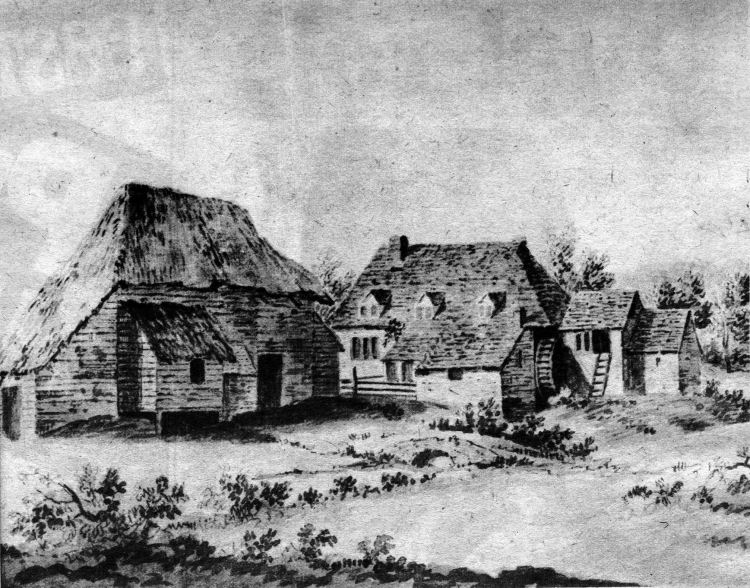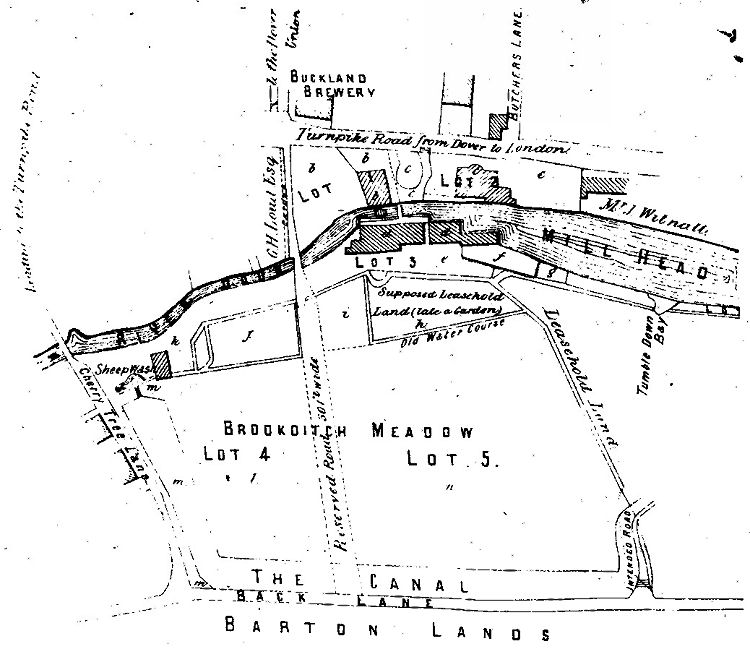Page Updated:- Sunday, 07 March, 2021. |
|||||
 Published in the South Kent Gazette, 8 April, 1981. A PERAMBULATION OF THE TOWN, PORT AND FORTRESS. PART 171.
GIPSY STOLE CHILD Later Buckland farm was held by Mr Horne, the owner of the paper mill adjoining Buckland Bridge, and was let to a fanner named Quested; of whom it is related that, about the year 1820, he lost his little daughter, named Bessie, who, when playing in Crabble meadows, was decoyed away by a gipsy woman. Fifteen years later, the girl was found with some gipsies hop-picking near Maidstone. In 1880 the land was being farmed by a Mr Marsh who, by reason of his meanness and bad temper, was commonly known as “Misery Marsh.“ Later it was held by George Brett, then licensee of the Bull Inn.
BUCKLAND MILL The prominent feature at Buckland Bridge for over 200 years has been Buckland paper mill, the last survivor of at least six paper mills which once straddled the tiny stream known as the River Dour. Other mills were at Bushey Ruff, River, Crabble, Lower Buckland and Charlton. The mill, owned by Messrs Wiggins Teape and Company Ltd., is a large, substantial structure which, by 1906, occupied an area of about 200 feet square, extending from the London Road on the north, to the church path on the south. In the past 70 years or so the mill complex of buildings has extended up the course of the river, which passes under the main building, over part of the land which used to be known as Crabble Meadows. A dominant feature for many years has been the clock tower on the Crabble Hill side. The paper mill dates from long before the bridge was built, the land and water it covers having been originally glebe attached to the church. Tradition speaks of a com mill at this spot, and probably there was one here before paper-making was introduced. About the year 1777, Mr Ingram Home figured as a paper manufacturer and a landowner in Buckland. About that time he is said to have established or taken over this paper mill. .Within the next twenty years the mill was burnt down and rebuilt. Hasted, writing in 1790, says: “This paper mill has been recently very much enlarged.“ In the year 1819, when Mr William Phipps was the owner, another writer states that this mill was carried on b$ Mr Thomas Home, possibly a son of Ingram Home. Thomas is recorded as owning the mill as early as 1799 and he rebuilt it after the fire destroyed it in 1814. His keystone and initials, together with the date 1814, were put over the great water wheel. A Cover guide book of 1819 records that “At Crabble is an extensive paper mill, the property of Messrs William Phipps and Sons, in which there is a curious patent machine for making paper Of any length whatever.“ It is thought that this machine was only the second of its kind to produce paper efficiently in endless sheets and it was certainly one of the first in the country. It-is believed to have been installed at Crabble Mill in about 1807. Thomas Horne had a plan drawn up which indicates that in 1822 he too considered acquiring a similar machine at Buckland, and one was eventually installed in about 1830. In the 1820s the mill was a two-storey building, with brick to the first floor and wood above. After the Homes retired the Buckland Mill passed, between 1825 and 1828 to Mr George Dickenson who was a brother of John Dickenson who founded an internationally-known firm of paper-makers of the same name-George married Miss Emma Pector, of a well known local family, and subsequently built a new paper mill in Charlton. After Mr Dickenson came Mr William Weatherley who made paper at Buckland in 1846.
MORE MILL FIRES For a short time the mill was shut down but in 1840 along came Mr Charles Ashdown who bought the mill and ran it assisted by his younger son Henry. He retired 30 years later and Henry took over but died shortly afterwards. The elder son Charles, a banker in Dover, then went into partnership with Mr Henry Hobday, a paper-maker, in September 1879, and bought the mill from Mr Ashdown senior, running it as Ashdown and Hobday. They greatly improved the machinery but soon after, on 25th September, 1887, the mill was totally destroyed by fire. This blaze and the fire in Home’s time cleared the way for building a new and enlarged mill. The extensions and improvements in the early days were on a comparatively small scale, for at no time prior to 1879 did the output exceed two tons per week; but the entire remodelling of the establishment, after the fire of 1887, altered the character of the works, and in less than a year the output of this mill was raised to twelve tons per week, the organising faculty of Mr Henry Hobday having had much to do with that transformation. In 1888 the Conqueror quality paper was made for the first time at the Buckland Mill for Wiggins Teape and Company Ltd. In July 1890 Ashdown and Hobday, sold out to Wiggins Teape, a firm which had a number of paper mills in various parts of England and was steadily buying more. Mr E. P. Barlow, JP, a member of that firm, took up his residence here as the local director, and Mr Henry Hobday the post of manager. For about three years the new firm contented itself with the new buildings and machinery provided by Messrs Ashdown and Hobday, after which very extensive additions were made to the buildings and the plant, with a view to turning out the highest quality of writing paper, and a large increase in the quantity, the output of the finished article soon rising to more than 30 tons per week.

One of at least six paper mills which have made use of the water power provided by the humble River Door this is Buckland Mill as depicted by an artist, T. Forest, who painted the old mill from St. Andrew’s churchyard in 1770. Now its modern counterpart is the-only one left working. Part of a second mill, at Crabble, which, like the Buckland mill, was badly damaged during the last World War, also survives. The 1770 mill was small and its production per week would have been limited to a few hundredweights. Paper making at Buckland has been briefly interrupted during the past 204 years by three disastrous fires which destroyed a succession of mill buildings but each time they were promptly rebuilt.

An interesting century-old map from the abstract of title of the trustees of the will of Dover brewer and miller Mr Alfred Kingsford, who died on 11th December, 1878, to some of his property between Barton Road and London Road. Buckland Brewery is shown at the foot of Coombe Valley Road while the mill is on the opposite side of London Road. The document was sent to us by Mrs Dorothy Dale, of Lwne Road.
|
|||||
|
If anyone should have any a better picture than any on this page, or think I should add one they have, please email me at the following address:-
|
|||||
| LAST PAGE |
|
MENU PAGE |
|
NEXT PAGE | |